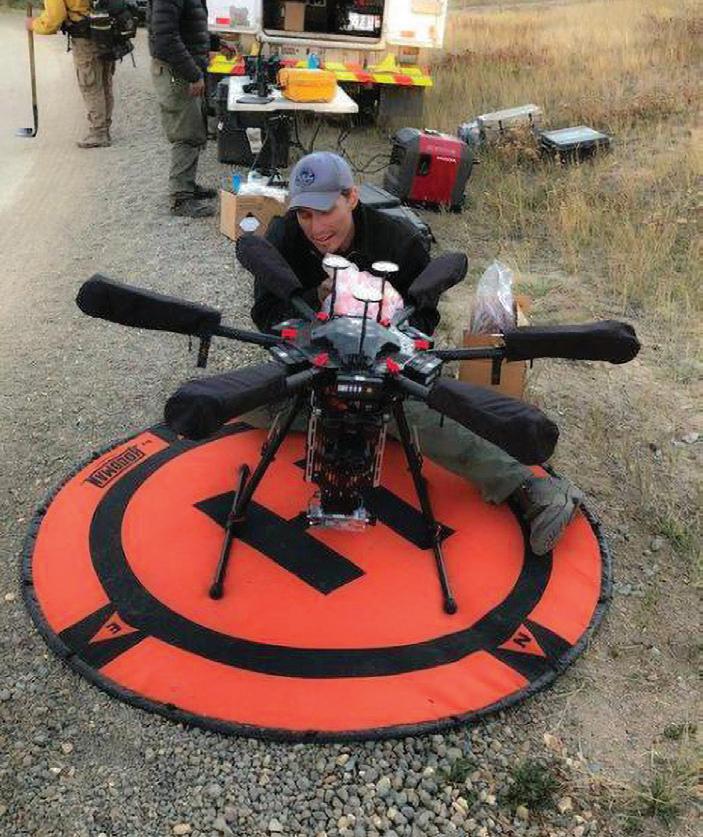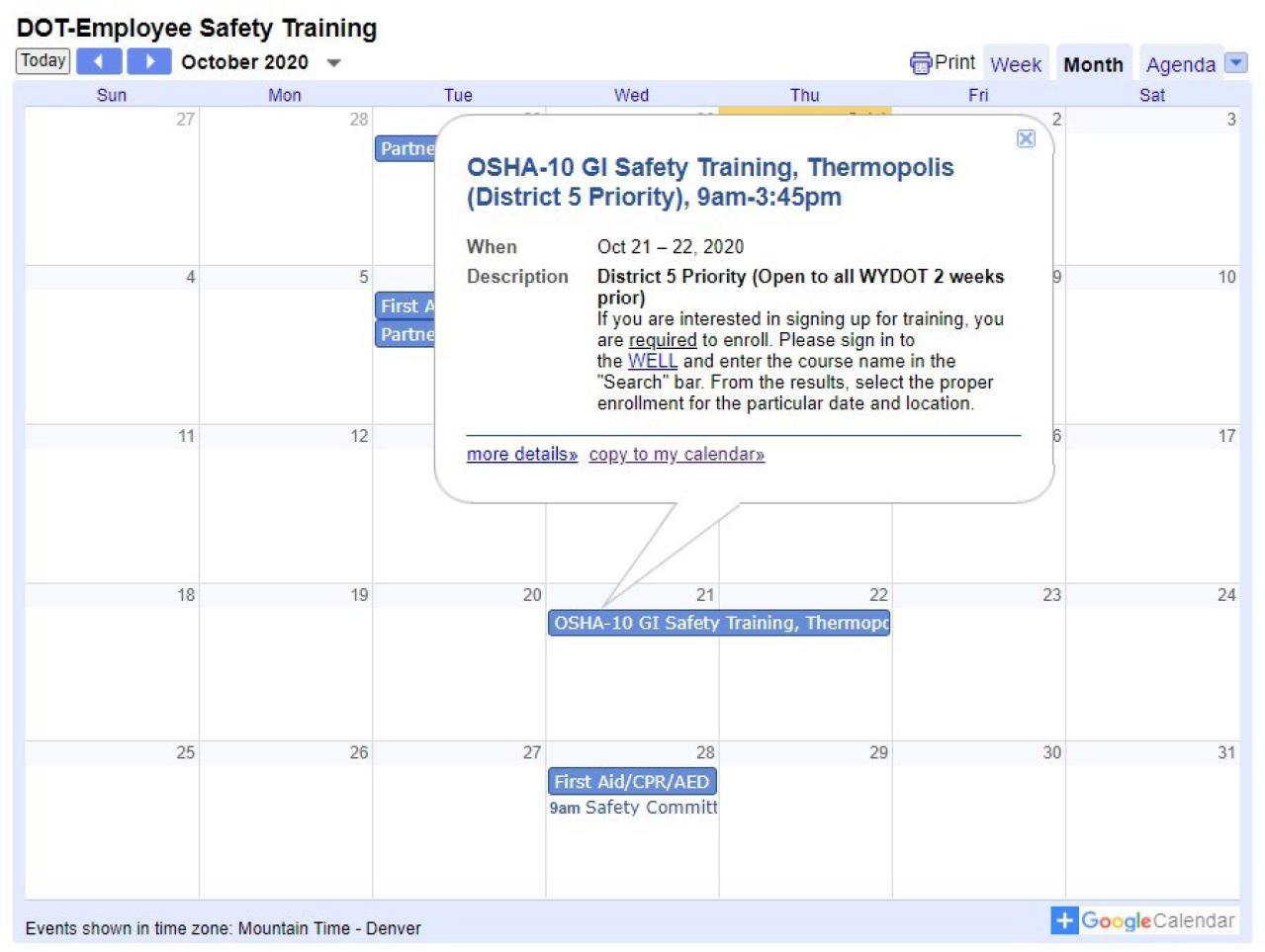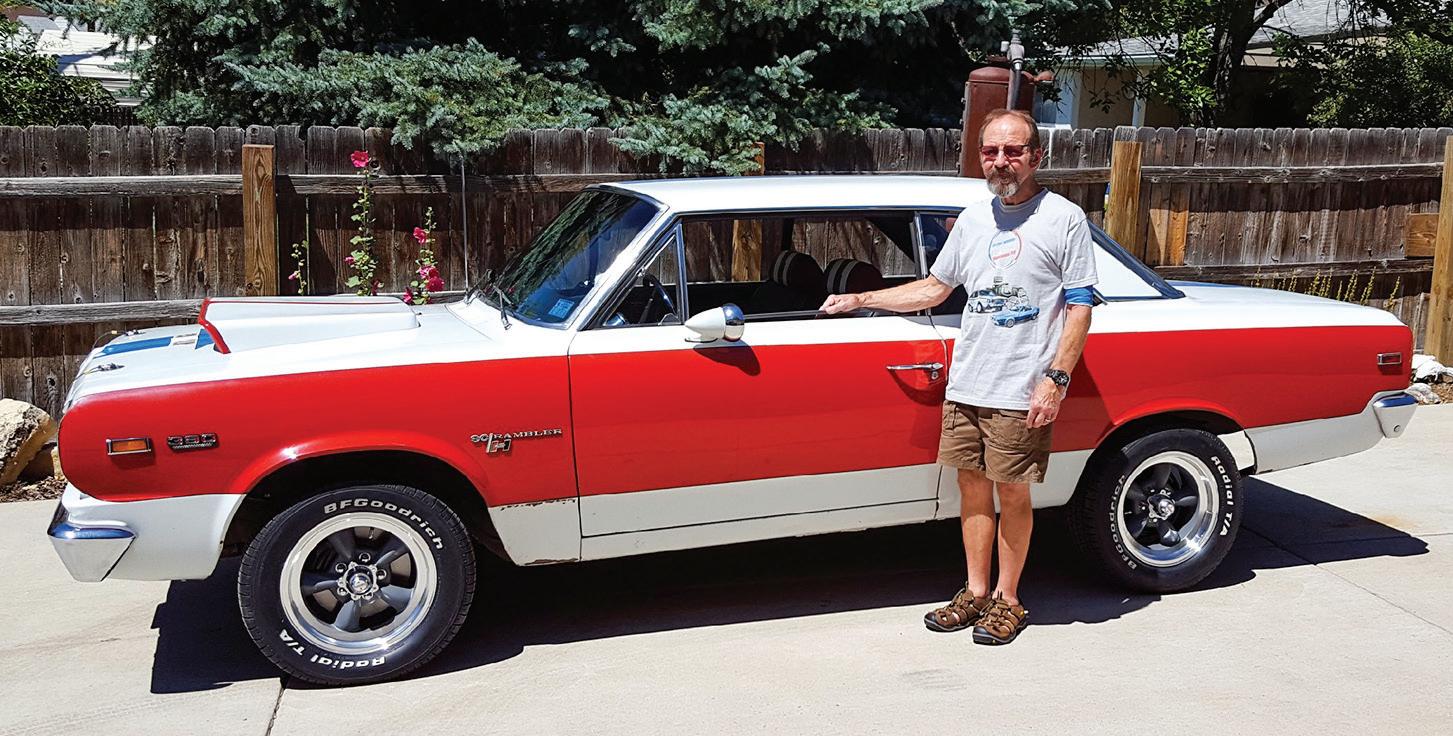
20 minute read
By the Numbers
from December 2020 Interchange
by WYDOT
Briefs continued from page 3 order; crews moved to different locations based on weather conditions and equipment or material availability.
Motorists encountered flaggers and potential short delays as crews worked.
Southeast Welcome Center closed for weekend
CHEYENNE – The Southeast Welcome Center near mile marker 4 on I-25 was temporarily closed for the weekend beginning on Oct. 30 due to concerns with COVID-19 exposure.
The closure remained in place while the facility was cleaned and reopened Nov. 6 once the cleaning process was complete.
Facilities, including restrooms and tourism information areas, were closed to the public. Parking remained available.
Ramp closure on US 85/ South Greeley Highway
CHEYENNE – The on-ramp leading motorists from US 85/South Greeley Highway to the westbound lanes of I-80 was closed briefly Nov. 3 as a Roadway Evaluation Crew tested the bridge deck for delaminations.
The closure began around 8 a.m. and ended around noon.
A detour was in place, so motorists planning on using the on-ramp were urged to plan alternate routes and a little extra time to get to their destinations.
CHEYENNE – The BNSF Railway Company closed West Lincolnway from Snyder Avenue to Bent Avenue Nov. 1-6 for railroad crossing repairs. Detours were in place and business access in the area maintained. Work was complete by Nov. 6.
The implemented detour route for westbound travelers directed traffic north at Carey Avenue, then west onto West 20th Street, and back south on Snyder Avenue to rejoin West Lincolnway.
The implemented detour route for eastbound travelers directed traffic north at Snyder Avenue, then east onto West
The above map shows the detour routing for the work done on West Lincolnway. The westbound traffic was detoured at Carey Avenue, while eastbound traffic was detoured at Snyder Ave.
Photo: WYDOT
District 2
Pursuit ends north of Douglas
DOUGLAS – A California resident is in custody following a pursuit that took place Nov. 19, covering more than 140 miles.
The pursuit started when officers with the Gillette Police Department received a call of a subject impersonating a peace officer at a local gas station. The reporting party saw the subject leave the area in a gray 2019 Ford Edge. Officers with the Gillette Police Department located the suspect vehicle and attempted a traffic stop. The driver failed to stop and fled from the officers. WHP was requested to assist the Gillette Police Department with the pursuit on WYO 50 as it left Gillette's city limits.
Troopers joined the chase near Savageton. The pursuit continued south on WYO 50 with speeds exceeding 100 mph before heading eastbound on WYO 387 towards Wright. At the intersection of WYO 387 and WYO 59, the driver drove south toward Douglas. Attempts to deploy spike strips were initially unsuccessful by law enforcement involved in the pursuit. Information was given to the Converse County Sheriff’s office of the approaching vehicle pursuit. Converse County Sheriff’s deputies and WHP troopers successfully deployed spike strips around milepost six on WYO 59. The driver stopped the vehicle for a short time but would not exit the car. A short time later, the driver started to drive south a second time. In the interest of public safety, a WHP trooper attempted a Tactical Vehicle Intervention (TVI) maneuver to end the pursuit. The
Total number of employees: As of Nov. 1, 2020 1,900 One month ago 1,910 One year ago 1,937 WHP
suspect vehicle entered the barrow ditch before the driver tried to drive around law enforcement again to escape. Due to the driver's actions causing an imminent threat to law enforcement and public safety, a WHP trooper drove into the suspect vehicle, causing it to overturn.
The driver of the vehicle was not injured and was taken into custody without further incident. He has been identified as 39-year-old Lomita, California resident Jonathan David Suckow.
Suckow was charged with fleeing to elude, reckless driving, speed and other traffic-related offenses. Suckow could also be facing additional charges in Gillette.
Agencies involved in the pursuit were Campbell County Sheriff’s Department, Gillette Police Department, Converse County Sheriff’s Department and Douglas Police Department.
District 3
Preliminary construction work begins on Etna North
ETNA – WYDOT began work on the Etna North Project on US 89 between Etna and Alpine the first week of November.
WYDOT and contract crews removed the permanent fence along the job and installed a temporary fence in its place for the winter. Crews cleared and did some grubbing along the job site before the weather prevented them from working in the area.
Lower Valley Energy was also working within the job area, installing new power poles.
The Etna North Project was awarded to Avail Valley Construction, out of Afton, for $19.7 million. The project involves grading, draining, placing crushed base and bituminous pavement surfacing, full-depth reclamation and miscellaneous work on approximately 9.30 miles on US 89 beginning at mile marker 108.13 between Thayne and Alpine Junction. The completion date for this project is June 30, 2022. WYDOT moved vehicle brake check area on Teton Pass
JACKSON – WYDOT moved the vehicle brake check area from its current location at milepost 11 to the weigh station on the west side of the pass.
On Nov. 15, in conjunction with the seasonal trailer restriction on WYO 22 Teton Pass, WYDOT moved the current vehicle brake check area, located at milepost 11 on the top of Teton Pass and relocated it to the weigh station pullout at milepost 15.5.
“The brake check areas are not strictly for commercial vehicles, but any vehicle that may need to check their brakes or pull over for an emergency. Once the trailer restriction is in place, we are okay with moving the brake check area to the weigh station,” Interim District Engineer Tory Thomas said.
The brake check area at the top of the pass was open to public parking on Nov. 15. As a reminder, parking is restricted when snow control activities take place, indicated by the current black-on-white regulatory signs that read: “AVALANCHE CONTROL/PARKING AREA CLOSED WHEN FLASHING.” Typical control missions begin in the middle of the night, usually around 3 a.m. Generally, when WYDOT initiates a control mission, the flashing lights will begin flashing the night of the mission, earlier in the evening.
The vehicle arrestor on WYO 22 is currently under repair, but crews have worked to complete the work by the end of November. A runaway truck ramp approximately one mile up from the current vehicle arrestor location remained open for use.
“WYDOT will continue to evaluate and serve all aspects of the public within the resources given to us, with safety being the top priority for all who travel Teton Pass,” said Mark Gillett, WYDOT chief engineer.
The seasonal trailer restriction went into effect Nov. 15 and will continue through April 1. Any vehicles with a hitched trailer illegally accessing Teton Pass will be found in violation of running a road closure and subject to fines. For alternative routes, contact any Department of Transportation Port of Entry or Permit Station. District 4 identifies snow plan levels of service
SHERIDAN – Now that the winter season has settled in, WYDOT implemented its annual snow plan, giving guidance on how highways are cleared of snow and ice.
With budget constraints the department currently faces, WYDOT identified six levels of service and the routes that fall under those levels to help manage and work within those budget constraints while still maintaining adequate levels of service for plowing.
Within these constraints, highways will be plowed, but they may remain snow covered at times and overnight plowing may not happen or be minimized depending on the timing of a snow event. Priority will be the travel and passing lanes with road shoulders and approaches being secondary. WYDOT will continue to use road traction materials such as salt/ sand and liquid and granular de-icing products, and has a budgeted amount for those supplies.
“We will have to strictly adhere to our winter maintenance budget, which means there likely won’t be any wiggle room to go over budget if we have a particularly severe winter,” said WYDOT Director Luke Reiner. “However, we will continue to provide winter maintenance services based on our limited budget.”
When determining which roads fell under which level of service, interstates and school bus routes took priority. Each district will work closely with school districts to help ensure designated bus routes receive service, and to keep them abreast of changing conditions and closures.
The levels of service for the state’s highways are consistent throughout Wyoming. However a highway may receive one level of service in one district and receive a higher or lower level of service within another district which is typically a result of local daily traffic volume and/ or primary road usage.
Cleanup operations at the end of the storm are to be performed during normal scheduled working hours after all other levels of snow control service have been accomplished. This operation includes
Briefs continued on page 6
Briefs continued from page 5 the clearing of any snow blocked approaches, removal of drifted areas off the roadway, snow piles at intersections and turnarounds and other necessary cleanup.
WYDOT asks the public to do its part when traveling Wyoming’s highways. When encountering a snow plow, motorists should keep their headlights on so they are more visible to the plow drivers and others. Slow down. Motorists should travel a safe distance behind the plow to avoid crowding it and getting sand on their vehicles. Motorists shouldn’t pass a plow unless the path ahead of them is absolutely clear. Many times, the road ahead is worse.
District 4 maintenance techs look over plans to build an ACROW bridge during an October learning session.
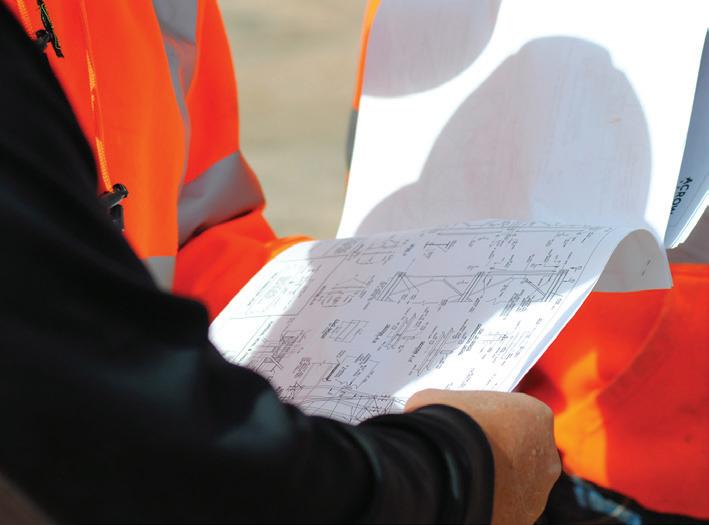
Photo: WYDOT
District 4 'erector set'
SHERIDAN – Many hands make light work and in this case many minds came together to assemble the pieces.
District 4 maintenance techs teamed up to learn how to erect an ACROW Bridge in October. An ACROW bridge is a portable bridge structure that can be placed as a detour when permanent bridges are either replaced or damaged. It was just five years ago WYDOT was called upon to replace a structure near Lusk that was washed out due to flash flooding. At the time, a team of 20-plus spent 23 days installing the structure.
Since then, many of those experienced techs have left leaving just a few who know how the structure comes together. Realizing that in the event of a similar need, Sheridan Maintenance's Dustin Hockett and Buffalo’s maintenance foreman Tony Morris decided it was time to familiarize the crews with the process, terminology and learn first-hand how to build this structure.
When assembled, these 10 by 33 foot sections can span up to 123 feet, provide a 24 foot travel lane and can support up 6 Interchange n
District 5
Volunteers enjoy cleaning up county-area highways
RIVERTON – The view from Park County and Hot Springs-area highways improved in 2020 as hundreds of AdoptA-Highway volunteers cleaned their 2-mile highway sections.
In its 31st year, Wyoming’s Adopt-A-Highway program has nearly 1,000 participating groups in Wyoming.
Cody-area groups include: First Presbyterian Church; Wapiti Women's Club; Cody VFW Post 2673 Auxiliary; Trout Creek Ranch; Rozanne and Doug Reachard; Smith Family; Cody Masonic Bodies; Dano Youth Camps; Powell LDS Youth; Cody Fed Ex Ground; South Fork Community Clicks 4-H Club; The Krenning Family; Best Westerns of Cody, Sunset Property; Rotary Club of Cody; Trinity Lutheran Church; Ride Safe in Memory of Cujo and Joe Boydston; Carl and Millie Krenning Family; Powell Swim Club; The Edmonds Family; Dexter Dearcorn Family; Rocket and Groot; Filkin and Shipp; Sunlight Landowners Association; Tom and Carol Wagner; and Civil Air Patrol Cadet Squadron.
Hot Springs County-area groups include: Patricia Wahler Memorial; Big Horn Enterprises; Kiwanis Club; Knights of Columbus 2578; Thermopolis Rotary Club; Central Wyoming 4X4 Association; In Memory of Brenna Rankin; Thermopolis FFA Chapter; Russ and Carol Dowdy; and Russell Ranch. "We really appreciate the volunteers who work to clean up highways in Northwest Wyoming," said Roni Stott, AdoptA-Highway coordinator for the Wyoming Department of Transportation in Cody. "These volunteers provide an invaluable service in helping to keep Wyoming beautiful. We really appreciate this volunteer service," said Shane Wilson, Wyoming Department of Transportation maintenance foreman in Thermopolis.
Volunteers providing this public service range from retired people to elementary school children. Groups represent fraternal, civic and social clubs, youth groups, employee and professional organizations, schools, churches, government agencies and families.
Signs identifying the groups are posted at each end of their adopted highway section, and WYDOT supplies safety brochures, orange vests and trash bags to the volunteers for each cleanup.
Winter closure of US 14A
BURGESS JUNCTION – The annual fall closure US 14A between Burgess Junction and Lovell took place Nov. 16.
The annual winter closure of US 14A, west of Burgess Junction, is at milepost 76.04 on the Lovell side of the Bighorn Mountains. The seasonal road closure at Burgess Junction is just east of milepost 98.1. WYDOT annually closes this 22-mile stretch of scenic mountain road in the Bighorn Mountains of north-central Wyoming in November. It usually opens for the summer by Memorial Day weekend.
SHOSHONI – Waltman Rest Area between Shoshoni and Casper has reopened after electrical work was completed inside the rest area facility.
Parking lot improvements at the rest area are part of the current project constructing seven sets of passing lanes between Shoshoni and Casper on US 20/26. The parking lot improvements will be completed next spring. Work at the Waltman Rest Area includes removal of existing pavement surfacing, grading, leveling and repaving of the rest area parking area.
“We will close the rest area again next spring and the contractor will complete work on the rest area parking lot at that time,” said Wyoming Department of Transportation resident engineer Kaia Tharp of Thermopolis.
The $5.8 million project begins east of Moneta (milepost 76) and continues to Waltman (milepost 51.6). Paving of the passing lanes is currently under way.
Mountain Construction Co., of Lovell, is the prime contractor on the US 20/26 passing lane project. The contractor was awarded the contract on July 18, 2019, by the Wyoming Transportation Commission. n
By Aimee Inama
The Wyoming Department of Transportation revamped its authorized travel program to offer more travel options during wintry conditions that will help improve traffic flow. WYDOT recently launched the Wyoming Travel Authorization Program (W-TAP) that creates different types of travel authorizations that it can issue when travel is safe.
Under the new W-TAP, those with Wyoming driver licenses can apply to receive WYDOT Authorized Travel (WAT) authorizations, Rolling Closure Authorizations (RCA) or both if needed. Those without Wyoming driver licenses can apply to receive WAT authorizations only.
The program also offers a W-TAP Memorandum of Understanding, or MOU, which is between an organization and WYDOT. The W-TAP MOU is intended for organizations and not individuals. It addresses travel needs not easily addressed through the automated WAT and RCA processes.
“Travel restrictions occur on the state’s roads in the winter due to conditions, crashes and other unforeseen events,” said Vince Garcia, ITS/GIS manager. “Our new program offers different authorizations based on what a traveler signs up for. As a reminder, participation in W-TAP does not grant blanket approval
The Hometown Hero program is a nationwide program the Girl Scouts participate in each year where troops choose different local heroes within their communities and donate some of their to travel on any closed road. WYDOT will continue to only allow travel on roads that are closed when it is safe to do so and under certain circumstances.”
The WAT application is open to all drivers but requires justification as to why a driver will need to travel on a closed road. Motorists are allowed to select seven segments of travel routes when applying for WAT.
Rolling Closure Authorizations (RCA) are primarily for those with Wyoming driver licenses. Motorists do not need to provide a travel justification as part of the application process but must agree to the terms of the program.
“Rolling Closure Authorizations are intended to allow drivers with Wyoming driver licenses to travel during any rolling closure, even if they did not specifically request travel authorization for the affected route,” Garcia said.
RCAs and WATs will be put in place with every rolling closure, unless Wyoming Highway Patrol personnel are required but not available. WATs will be considered with every road closure.
Program participants will be notified by email when authorizations are in place. In addition, they can access travel status via an automated phone system, their W-TAP account (https://w-tap.wyoroad. info/) and the Wyoming 511 mobile app.
With the move to the new W-TAP, WYDOT deleted all data from the previous program to ensure privacy.
“Even though some motorists may have participated under the previous WAT program, they will need to still reapply for W-TAP,” Garcia said.
For Wyoming drivers, the online application asks for a person’s name, date of birth and driver license number. That information is used to verify a person’s driver license and to retrieve address information, which is then verified with the United States Postal Service to ensure mail delivery. A person’s date of birth and driver license number will not be saved in the W-TAP database.
Wyoming residents who meet certain criteria will receive automatic approval. WYDOT officials review out-of-state applications before giving approval. Outof-state applicants provide their name and address when applying.
Drivers who want to apply to the program can visit wyoroad.info and click on n
Landscaping project? Hunt lately?
Hometown Heroes from members of the public; they buy a box and donate a box to the program.
Girl Scout Troops 1482 and 1228 in Members of both troops visited the Laramie chose WYDOT Maintenance Laramie shop to give the crew their cookCrews/Snow plow drivers as their home- ies and to check out a snowplow up close town heroes this year. — while wearing masks, of course! n
the W-TAP icon. delicious cookies. Often these cookies are bought as gifts Photo: WYDOT District 1 Maintenance crew and snowplow drivers were chosen as Laramie Girl Scout Troops 1482 and 1228 as their hometown heroes.
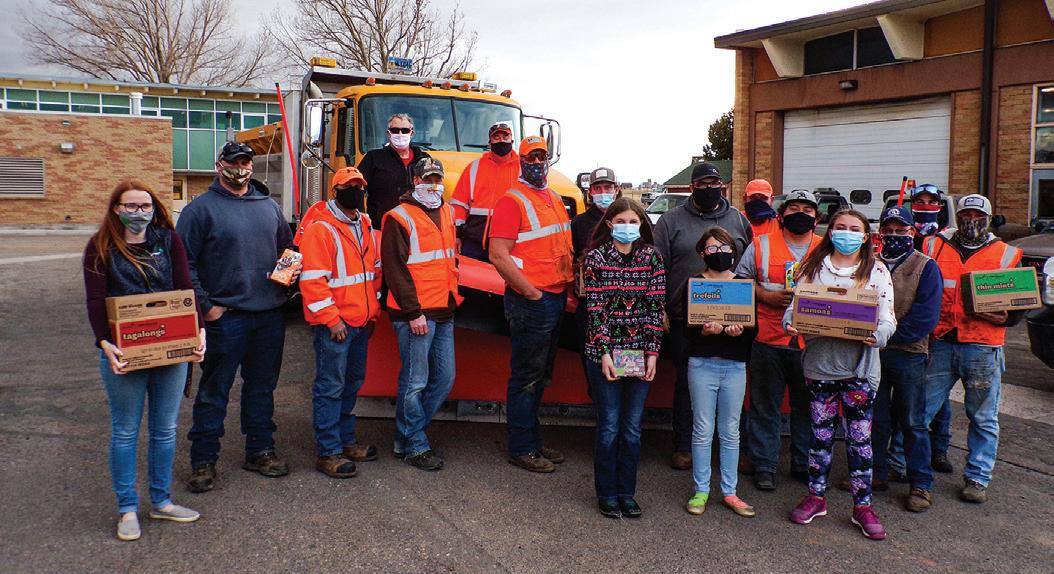
Show us what you’ve done during COVID!

WYDOT assists with firefighting effort during Mullen Fire

Photo: Zach Alexander By Jordan Achs
This fall was a tough fire season for the entire Mountain West region, including in southeastern Wyoming.
First spotted Sept. 17, the Mullen Fire raged through the Medicine Bow National Forest in southern Carbon and Albany counties, even touching into Colorado before it started to fizzle out with the coming winter.
As of writing this, the blaze burned nearly 177,000 acres and damaged 66 structures. Much of that fire growth happened in a short time; on Sept. 26, the daily firefighter operations report noted the fire grew over 33,000 acres. Rugged wilderness, extreme winds and downed and dead beetle-kill trees fueled the flames.
WYDOT employees including Highway Patrol troopers, airports, maintainers and the Transportation Management Center assisted firefighters in the effort to fight one of Wyoming’s largest fires to date.
“Large wildfires, such as the Mullen Fire, require close coordination with many partners,” said USFS Laramie District Ranger Frank Romero. “WYDOT has always been a key partner in the work that we accomplish and is always willing to show up and lend a hand. This was apparent throughout the Mullen Fire and all previous fires I’ve been a part of.”
Due to the rugged terrain of the area, much of the firefighting efforts had to be via aerial operations.
Fixed-wing aircraft like planes used the runways at the Laramie Regional Airport and the Cheyenne Regional Airport, while helicopters used a makeshift heli-base near Centennial. “There were probably 15-20 aircraft working the fire out of here,” Jack Skinner, Laramie Regional Airport manager, said. “September was our best fuel sales month on record.”
He added some days they had to store planes on the taxiway because the hangars and ramps were full.
When the fire was peaking in late September and early October, crews were using multiple helicopters, fixed-wing planes for Air Attack supervisors, four Single Engine Air Tanker (SEAT) aircrafts and four of its aquatic cousins, SEAT aircrafts with floats nicknamed the “Fire Boss” or “Super Scoopers.”
SEATs are nimble aircraft well-suited
A single engine air tanker (SEAT) aircraft dousing flames with water.

Photo: Melanie Johnson
to mountainous terrain, with the carrying capacity of up to 800 gallons of water or retardant at low altitudes (but less if needing to fly at higher altitudes.)
When not carrying retardant, Super Scoopers would fly down low to scoop water from nearby bodies of water like Rob Roy Reservoir or even Lake Hattie, where crowds would park and watch the spectacle.
Aircraft can only fly in the right conditions, however. Sometimes strong wind gusts — like the 70 mph gusts in the area on Sept. 26 — would force flying operations to ground.
Strong winds weren’t the only challenge firefighters encountered with aerial operations; on the morning of Sept. 28, pilots had to de-ice aircraft before flight, an uncommon task during most wildfires according to the firefighter operations reports for that day.
Beyond air support with chopper and plane, this fire relied heavily on unmanned aerial systems (UAS), more commonly known as drones. When conditions allowed, crews would use drones with infrared technology to map the fire perimeter, locate spot fires and guide firefighters to the spots for quick extinguishing.
Skinner said it’s becoming more common to work with the
A SEAT aircraft dropping fire retardant on the hillside.
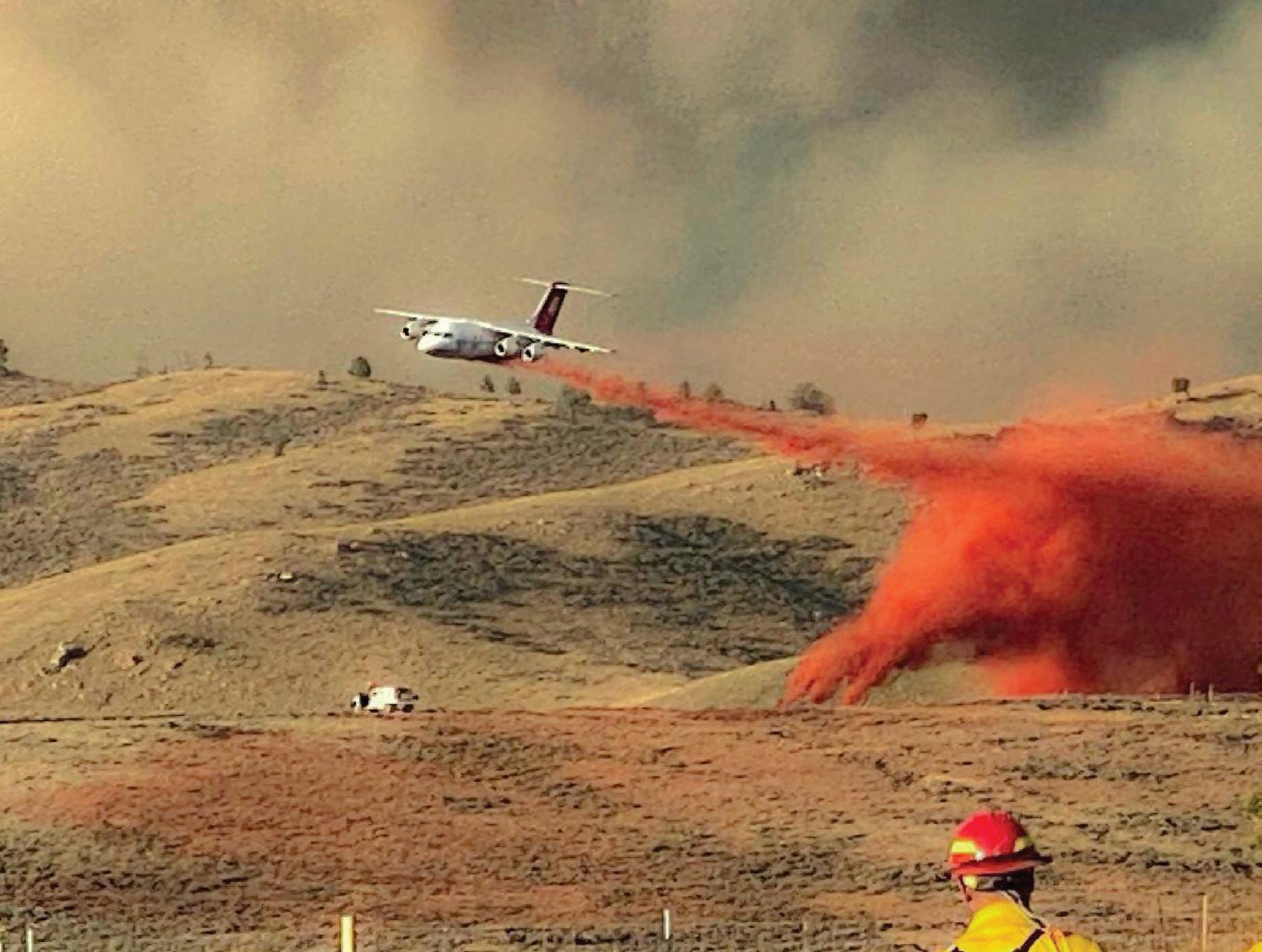
Photo: US Forest Service U.S. Forest Service and Bureau of Land Management on aerial fire support as fire seasons get more intense. The airport hosted Smoke Jumpers this year that would respond to different regional fires as needed. Additionally, some aircraft working the nearby Cameron Peak fire in Fort Collins used the Laramie Airport during their firefighting efforts.
On the ground, WYDOT crews helped firefighters with traffic control near the temporary heli-base, including placing “No Parking” signs to discourage ogling drivers and passers-by.
Portable and established dynamic messaging signs (DMS) were also used to display fire information for travelers along nearby WYO 230, WYO 130 and even parts of I-80. Additionally, TMC updated the 511 travel map and call menu to give travelers easy access to fire information and updates.
Maintenance crews responded to firefighter needs quickly and efficiently, including installing a temporary approach to Sodergreen Lake and providing traffic control at one of the firefighter bases at the Wyoming Army National Guard Armory in Laramie.
With a fire spanning nearly 200,000 acres, road closures and evacuations were to be expected. WYO 230, WYO 11 and WYO 10 saw extended closures as the fire progressed.
Wyoming Highway Patrol troopers manned gates (both established and makeshift) day and night to keep all who weren’t actively fighting the fire out of the evacuation zones and harm’s way. Keeping people out of the active fire areas helped keep not only the public safe, but firefighters, too.
Fortunately, winter comes early to that part of Wyoming, and currently the fire sits at 97% containment with more snow expected to finish the job soon. No area closures or evacua- Photo: US Forest Service tion notices remain in The Mullen Fire relied on unmanned aerial effect. systems, or drones, to support the planes and Unfortunately, burning that many choppers dropping the water and retardant on the fire. acres came with a heavy cost. The fire caused extensive damage, including in areas where WYDOT employees and their loved ones may have had property or fond memories. Condolences to any and all who have suffered a loss due to this or any other wildfire this season.
Thank you WYDOT crews for your hard work –—not only did you fulfill WYDOT’s Purpose and Mission, you also exemplified WYDOT’s key values: Respect, Integrity, Dedication, Excellence and Safety.
“Forest fires are just one example, as our relationship with WYDOT goes beyond emergency situations,” Romero said. “I know that if I need something, and WYDOT can assist, they are just a phone call away.” n
